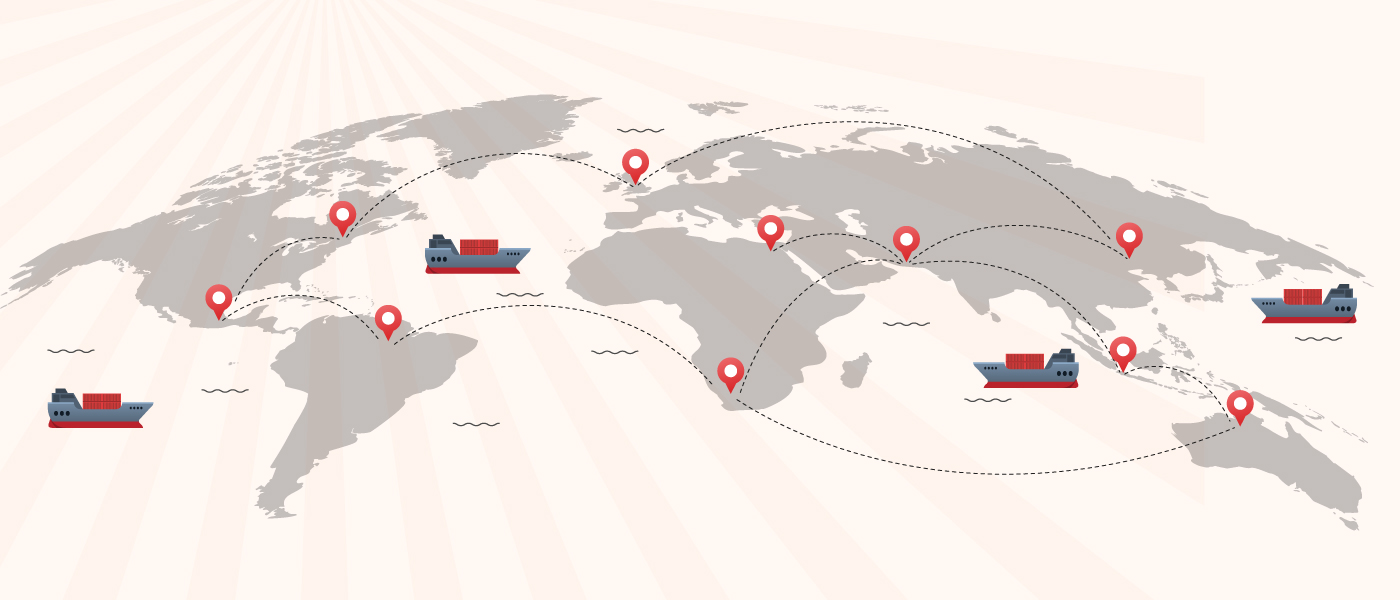The Nerves of Global Trade: Shipping Routes
- July 3, 2025
- Blog
In recent years, the shipping world has witnessed disruptions like never before, which have exacerbated the world’s prominent trade waterways, the supply chain lifelines of many countries’ industries and economies.

Some of the upheavals include pandemic lockdown, a reputed carrier vessel stuck in the Suez Canal, drought at the Panama Canal, the Ukraine and Russia war, attacks on the Red Sea, to name a few. According to IMO (International Maritime Organisation, these disruptions hugely impact the trade routes and the global economy, as 90% of trade is shipped via sea. Let’s explore the world’s most important trade routes that empower the global shipping world:
The Suez Canal
The Suez Canal is 200 km long and is considered the fastest and direct maritime trade link between Asia and Europe. Strategically located in Egypt, it connects the Mediterranean with the Red Sea and is a bifurcation line between Africa and Asia. The Suez Canal is the shortest trade route from Europe to Asia and is much more commonly used to avoid the long trip around the Cape of Good Hope in South Africa.
Around 20,000 vessels pass through the Suez Canal each year, which is approximately 12% of the world’s global trade, worth USD $ 1 trillion of goods annually.
The modern Suez Canal was completed in 1869 when Egypt was under French occupation. After several enlargements, the canal is now close to 200 km long.
The Suez Canal plays a major role in both trade and geopolitics, but recently it has been impacted by attacks on trade vessels in the Red Sea, leading to major supply chain disruptions.
The Panama Canal
The Panama Canal is a major waterway for global trade shipping, connecting Asia with the eastern seaboard of the United States. It’s human-created and requires locks to lift and lower ships as they move ahead across the Isthmus of Panama. With time, it has expanded and now even larger vessels avoid the long journey around Cape Horn in South America and use this canal.
Additionally, this canal connects around 2000 ports and manages more than 20000 transits each year as they journey between the Atlantic and Pacific Ocean.
The English Channel
The English Channel is the busiest trade lane globally, with over 500 vessels crossing through it every single day to get from the North Sea to the Atlantic and from the United Kingdom to Continental Europe and back.
The channel also handles an array of goods that includes consumer goods, industrial materials, oil and gas. Sometimes, the weather conditions might pose a challenge and can lead to delays, and the narrow Strait of Dover can result in congestion.
Each year, around 16 million people and 5 million trucks pass through 170 ports that are part of this channel, mainly Portsmouth, Le Havre and Cherbourg and Brest. The traffic volume of vessels loaded with containers contributes significantly to the economies of Europe and the UK.
The Malacca Strait
The Malacca Strait, nestled between Sumatra Island in Indonesia and the Malay Peninsula, is the shortest trade route between the Pacific and Indian Ocean. It extends from the Andaman Sea till the Strait of Singapore to South China Sea, connecting Asia’s major economies such as India, Singapore, South Korea, China, Malaysia, Taiwan and Japan.
Every year, around 94000 vessels cross through the Malacca Strait carrying around 30% of the global trade.
Moreover, this trade route is prone to collisions and regular congestion, but still, it is expected to exceed its limit as traffic continues to grow.
In 2024, Thailand proposed a new ‘Land Bridge’ venture to connect the Gulf of Thailand and the Andaman Sea to bypass the congested Strait of Malacca. This new project is part of the Southern Economic Corridor, wherein two deep-sea ports will be linked by a high-speed highway and railway connectivity. The shipments could be offloaded and transported by rail or road, prompting shippers to avoid the congested Malacca Strait. The objective of the new project is to reduce shipping time and cost to a large extent.
The Hormuz Strait
The Hormuz Strait links the Gulf of Oman with the Persian Gulf and Arabian Sea as it is wedged between Iran and Oman. Being a prominent shipping route for oil in the Middle East, the Hormuz Strait witnesses the shipment of over 21 million barrels passing through it each day. It also carries 20% of global liquefied natural gas (LNG) each year.
As this trade lane is busy with oil trade, it offers space for collision. To avoid that, the strait operates a 2-lane traffic system where inbound vessels use one lane and outbound vessels use the other.
Additionally, as this trade route is close to the Red Sea, there is always a geopolitical tension brewing for shipping companies operating in the Hormuz Strait.
The number of vessels moving around the world is increasing every year, carrying millions of containers and bulk cargo. In total, around 11 billion tons of cargo per year move across world’s busiest shipping lanes.
How can digital solutions assist in improving cargo movement?
The congestion in the world’s oceans is encouraging freight forwarders, shippers and port authorities to find solutions to manage congestion, yard space for shipments, etc.
20Cube Logistics help you in achieving these objectives by researching the best routes in the easiest way possible that will reduce transit time and manage operations efficiently, and avoid delays and congestion inside ports and in sea routes.
With the digital platform MyHub, you can easily calculate the best distances and transit times for planning shipments, predict the ETA, ETD and ATA. Additionally, easy booking helps in getting the container quickly attached to a shipment for transportation to its destination. It means faster planning, smart route mapping and on-time delivery for you. With 20Cube, you have complete control over your shipment as we keep on innovating to simplify your logistics operations.



